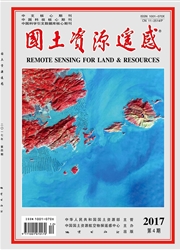

 中文摘要:
中文摘要:
为了更好地研究内蒙古额济纳盆地的土壤水分时空分布及动态变化,基于MODIS数据,利用热惯量模型,计算了表观热惯量,并与实测数据进行回归分析建模,反演了内蒙古额济纳盆地的土壤水分。结果表明,利用MODIS数据产品,反演参量获取简单,可降低反演土壤含水量的复杂性,有利于大、中尺度的实际应用;砂土对应的表观热惯量均值较大,粘土次之,壤土最小;相比粘土,壤土和砂土的表观热惯量值比较大且分散;绿洲区表观热惯量值比戈壁和沙漠区大;热惯量模型在20cm左右深度土壤水分反演效果最好,可有效反演干旱区土壤水分。
 英文摘要:
英文摘要:
In order to study the spatial and temporal distribution and the change of soil moisture in the lower reaches of the Heihe River Basin, the authors used the MODIS data products and the soil moisture data measured from the field data and adopted the thermal inertia to calculate the apparent thermal inertia (ATI). Then ATI and soil moisture were used to build the experience model by regression analysis. At last the soil moisture in the lower reaches of Heihe River Basin was successfully retrieved by this model. The results indicate that using MODIS products provided by NASA could predigest the retrieval parameters, reduce the complexity of soil moisture retrieval and ensure the application in the large or middle - sized region. The ATI mean of sand is larger than that of loam and clay, the ATI of clay and loam is relatively large and scattered. The ATI mean of the oasis area is larger than that of the gobi and desert area. The proposed thermal inertia model can reliably monitor the soil moisture within the soil depth of 20 cm.
 同期刊论文项目
同期刊论文项目
 同项目期刊论文
同项目期刊论文
 Significance and Effect of Ecological Rehabilitation Project in Inland River Basins in Northwest Chi
Significance and Effect of Ecological Rehabilitation Project in Inland River Basins in Northwest Chi Non-growing season soil CO2 efflux and its changes in an alpine meadow ecosystem of the Qilian Mount
Non-growing season soil CO2 efflux and its changes in an alpine meadow ecosystem of the Qilian Mount Hydraulic redistribution of soil water by roots of two desert riparian phreatophytes in northwest Ch
Hydraulic redistribution of soil water by roots of two desert riparian phreatophytes in northwest Ch Soil water and salt distribution under furrow irrigation of saline water with plastic mulch on ridge
Soil water and salt distribution under furrow irrigation of saline water with plastic mulch on ridge Geostatiscal analysis of temporal and spatial variations in groundwater levels and quality in the Mi
Geostatiscal analysis of temporal and spatial variations in groundwater levels and quality in the Mi Hydraulic redistribution of soil water by roots of two riparian forests phreatophytes in extremely a
Hydraulic redistribution of soil water by roots of two riparian forests phreatophytes in extremely a 期刊信息
期刊信息
